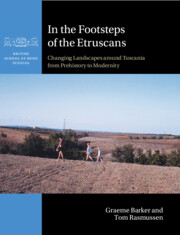Book contents
- In the Footsteps of the Etruscans
- British School at Rome Studies
- In the Footsteps of the Etruscans
- Copyright page
- Dedication
- Contents
- Figures
- Tables
- Contributors
- Preface and Acknowledgements
- 1 The Tuscania Archaeological Survey: Rationale, Aims and Objectives
- 2 Methodologies
- 3 The Natural Landscape and Its Evolution
- 4 Prehistoric Landscapes
- 5 Etruscan Urbanization, c. 700–300 bc
- 6 ‘Romanization’: The Roman Republican Period, c. 300–30 bc
- 7 The Roman Imperial and Late Antique Periods, c. 30 bc–c. ad 700
- 8 Incastellamento and Its Aftermath: Medieval and Modern Landscapes, c. ad 700 to the Present
- 9 A Mediterranean Landscape from Prehistory to Modernity
- Book part
- Bibliography
- Index
2 - Methodologies
Published online by Cambridge University Press: 12 October 2023
- In the Footsteps of the Etruscans
- British School at Rome Studies
- In the Footsteps of the Etruscans
- Copyright page
- Dedication
- Contents
- Figures
- Tables
- Contributors
- Preface and Acknowledgements
- 1 The Tuscania Archaeological Survey: Rationale, Aims and Objectives
- 2 Methodologies
- 3 The Natural Landscape and Its Evolution
- 4 Prehistoric Landscapes
- 5 Etruscan Urbanization, c. 700–300 bc
- 6 ‘Romanization’: The Roman Republican Period, c. 300–30 bc
- 7 The Roman Imperial and Late Antique Periods, c. 30 bc–c. ad 700
- 8 Incastellamento and Its Aftermath: Medieval and Modern Landscapes, c. ad 700 to the Present
- 9 A Mediterranean Landscape from Prehistory to Modernity
- Book part
- Bibliography
- Index
Summary
The primary technique employed in the project was ‘field walking’: systematically collecting archaeological artefacts lying on the ground surface, especially in ploughsoil.The method has been widely employed by archaeologists working around the Mediterranean to map past settlement especially because of the suitability of its semi-arid landscapes for this kind of ground searching.An apparently simple technique, systematic archaeological survey in fact has to deal with a wide range of biasing factors as every stage, so this chapter describes the decisions we took and the methods we employed, and assesses their implications for the quality of the information retrieved: defining the study area (totalling 353 km2);the employment of three sampling methods (Transect, Random and Judgement, totalling 97 km2) to survey the landscape; the decisions we took about the intensity of search and artefact collection methods (41.5 km2 were searched) and about defining ‘sites’- assumed foci of activity -versus ‘off-site’ or sporadic material thought to indicateland use activities such as manuring; and in our subsequent analyses of the materials collected, the methods we used to try to minimize the biasing effects of the surface archaeology of different periods of the past being differentially prolific and/or differentially visible.
Keywords
- Type
- Chapter
- Information
- In the Footsteps of the EtruscansChanging Landscapes around Tuscania from Prehistory to Modernity, pp. 28 - 60Publisher: Cambridge University PressPrint publication year: 2023



